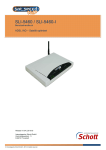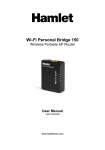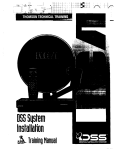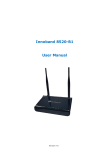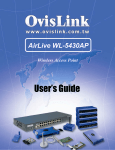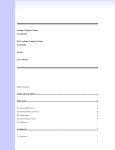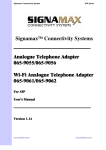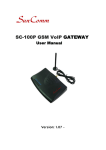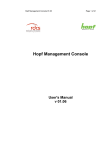Download SATSPEEDBOX III R7920 User Manual Gigabit Ethernet
Transcript
Informationstechnologie-Lösungen
Gigabit Ethernet IAD 11n
SATSPEEDBOX III R7920
User Manual
Table Content
Prefaces ............................................................................................................... 4
About This Manual ........................................................................................... 4
Copyright Declarations .................................................................................... 4
Trademarks ..................................................................................................... 4
Safety Instructions .......................................................................................... 4
Audience .......................................................................................................... 4
Introduction .......................................................................................................... 5
Overview ......................................................................................................... 5
Introduction .................................................................................................... 6
Front Panel LED Indicators & Rear Panels SATSPEEDBOX III R7920 ............... 6
Introduction .......................................................................................................... 7
Package Content .............................................................................................. 7
Hardware Installation ...................................................................................... 8
Port Description: Model SATSPEEDBOX III R7920 ................................................ 8
Quick Start ....................................................................................................... 9
Installation: .................................................................................................... 9
Connecting to a PC: ......................................................................................... 9
How to configure SATSPEEDBOX III R7920? ........................................................ 9
How to use VoIP? ............................................................................................. 9
Wizard Setup ................................................................................................. 10
Step 1. Connection wizard................................................................................10
Step 2. Welcome to the Connection Wizard ........................................................10
Step 3. Time Zone Setup .................................................................................11
Step 4. LAN Port Type Setup: ...........................................................................11
Step 5. WAN Port Type Setup: ..........................................................................11
Step 6. Wireless Interface Setting .....................................................................13
Step 7. Voip Setup ..........................................................................................14
VOIP Setup ..........................................................................................................15
WAN Interface ............................................................................................... 15
Broadband .....................................................................................................18
LAN Interface ................................................................................................ 19
Client List ......................................................................................................19
DDNS ............................................................................................................. 20
QoS ................................................................................................................ 21
Wireless ......................................................................................................... 21
Advanced Setting ............................................................................................22
Security .........................................................................................................23
Key Length: ...................................................................................................24
Access Control ................................................................................................25
WDS .............................................................................................................25
Site Survey ....................................................................................................26
WPS ..............................................................................................................26
SIP Setting and “Emergency Routine” .....................................................................27
SIP Setting.....................................................................................................28
Sip Advance setting.........................................................................................29
Codec Setting .................................................................................................33
ToS ...............................................................................................................34
Telephone ...................................................................................................... 35
Common ........................................................................................................35
Analog Phone .................................................................................................36
Region ...........................................................................................................39
Phone Book.................................................................................................... 40
Speed Dial .....................................................................................................40
Dial Plan With URL ..........................................................................................41
Security ..............................................................................................................42
SATSPEEDBOX III R7920 Manual
Page 2
Firewall .......................................................................................................... 42
IP Filtering .....................................................................................................42
Mac Filtering...................................................................................................43
URL Filtering ..................................................................................................43
Port Filtering ..................................................................................................44
Port Forwarding ..............................................................................................44
DMZ ..............................................................................................................45
Maintenance ........................................................................................................46
System ........................................................................................................... 46
Account Setting ..............................................................................................46
Time Setting ..................................................................................................46
Tools .............................................................................................................. 47
Configuration .................................................................................................47
Upgrade Firmware...........................................................................................47
Ping Test .......................................................................................................48
Restart ..........................................................................................................48
Logout ........................................................................................................... 49
Auto Provision / TR069 ................................................................................. 49
HTTP / FTP .....................................................................................................49
TR069 ...........................................................................................................50
Information .........................................................................................................51
System Status ................................................................................................ 51
USB ACCESS ........................................................................................................52
File server ...................................................................................................... 52
Permanent file access ......................................................................................53
Printer server ................................................................................................ 54
Installation steps: ...........................................................................................54
Appendix .............................................................................................................56
A - FAQ List .................................................................................................... 56
B - Scenario Application: ................................................................................ 57
Glossary ..............................................................................................................58
Certifications........................................................................................................64
CE / FCC / RoHS ............................................................................................ 64
FCC ...............................................................................................................64
FCC Class B Notice ..........................................................................................64
IC Statement..................................................................................................64
EC Declaration of Conformity ......................................................................... 64
WEEE – B2C ........................................................................................................65
Candle Flame .......................................................................................................66
Warning for users ...........................................................................................66
SATSPEEDBOX III R7920 Manual
Page 3
Prefaces
About This Manual
This manual is designed to assist users in using SATSPEEDBOX III R7920 Gigabit
Ethernet IAD. Information in this document has been carefully checked for accuracy;
however, no guarantee is given as to the correctness of the contents. The
information contained in this document is subject to change without notice.
Copyright Declarations
Copyright 2012. All rights reserved. This publication contains information that is
protected by copyright. No part may be reproduced, transmitted, transcribed,
stored in a retrieval system, or translated into any language without written
permission from the copyright holders.
Trademarks
Products and Corporate names appearing in this manual may or not be registered
trademarks or copyrights of their respective companies, and are used only for
identification or explanation and to the owners’ benefit, without to infringe.
Safety Instructions
The most careful attention has been devoted to quality standards in the manufacture
of the SATSPEEDBOX III R7920 Gigabit Ethernet IAD. Safety is a major factor in the
design of every set. But, safety is your responsibility too.
Use only the required power voltage. Power Input: AC 110V/220V, 50-60Hz
To reduce the risk of electric shock, do not disassemble this product. Opening
or removing covers may expose the SATSPEEDBOX III R7920 to hazardous
voltages. Incorrect reassembly can cause electric shock when this product is
subsequently used.
Never push objects of any kind into the equipment through housing slots
since they may touch hazardous voltage points or short out parts those could
result in a risk of electric shock. Never spill liquid of any kind on the product.
If liquid is spilled, please refer to the proper service personnel.
Use only Unshielded Twisted Pair (UTP) Category 5 Ethernet cable to RJ-45
port of the SATSPEEDBOX III R7920 Gigabit Ethernet IAD.
Audience
This document is intended for system vendor who are using SATSPEEDBOX III R7920
to build an Internet telephony gateway or server application. It is assumed that the
reader has the general knowledge of VoIP applications and products.
SATSPEEDBOX III R7920 Manual
Page 4
Introduction
This document describes the usage of SATSPEEDBOX III R7920.
Overview
SATSPEEDBOX III R7920 is a device that allows several PC or IPTV Set-Top
Boxes to connect and to browse the Internet.
SATSPEEDBOX III R7920 provides two RJ11 analog interfaces for VoIP calls,
PBX, fax machines or any analog telephone.
SATSPEEDBOX III R7920 Manual
Page 5
Introduction
The SATSPEEDBOX III R7920 Ethernet Gigabit IAD 11n provides a total solution
for integrating voice-data network and PSTN.
The SATSPEEDBOX III R7920 Ethernet Gigabit IAD 11n supports SIP VoIP
Protocol.
The SATSPEEDBOX III R7920 Ethernet Gigabit IAD 11n allows 1~2 lines
analog voice and fax communication over a traditional data
communications/data networking digital Internet.
Model
SATSPEE
DBOX III
R7920
PSTN Port
FXS
Port
WAN
Port
0
2
1
LAN Port RJ-11 port
4
2
USB
SIP
1
Front Panel LED Indicators & Rear Panels
SATSPEEDBOX III R7920
LED
State
Description
POWER
On
Off
On
Flashing
Off
On
Flashing
Off
On
Flashing
Off
On
Off
On
Flashing
Off
On
Off
Device is powered on
Device is powered off
Network connection established
Data traffic over WAN interface
Waiting for network connection
LAN is connected successfully
Data is transmitting
No connected Ethernet device
Wireless network connection available
Data traffic over WLAN interface
Wireless network connection disabled
Successful registered on VoIP Account
Not registered on VoIP Account
Telephone set is On-Hook
Phone is ringing
Telephone set is Off-Hock
No USB device connected
USB device connected
WAN
LAN1 – LAN4
Wi-Fi
REG
PHONE1
PHONE2
USB
-----------------------------------------------------------------------------------SATSPEEDBOX III R7920 Manual
Page 6
Introduction
Package Content
Please check enclosed product and its accessories before installation. These contents
may differ slightly depending on your product version.
SATSPEEDBOX III R7920
Ethernet Cable
Phone Cable
Power Adapter
SATSPEEDBOX III R7920 Manual
Page 7
Hardware Installation
Port Description: Model SATSPEEDBOX III R7920
Port
POWER
PHONE1
PHONE 2
USB
LAN(Local Area
Network)
WAN(Wide Area
Network)
RES(Reset button)
SATSPEEDBOX III R7920 Manual
Description
Power connector for 12V/1.5A power adapter
Phone ports are made to connect analog phones for
VoIP
USB interface for SAMBA, Printers and 3G stick
Connect to PC with Ethernet cable. 1 port allows your
PC or Switch/Hub to be connected to the device
through a networking cable with RJ-45 connectors
used on 10BaseT and 100BaseTX networks.
Connect to the network with an Ethernet cable. This
port allows your device to be connected to an
Internet Access device, e.g. router, cable modem,
ADSL modem, through a networking cable with RJ-45
connectors used on 10BaseT and 100BaseTX
networks.
Push this button until 3 seconds, and device will be
set to factory default configuration.
Page 8
Quick Start
Installation:
1. Connect the 12V DC IN to the power outlet with power adaptor.
2. Connect blue WAN port with the Ethernet cable to a WAN network.
3. Connect your existing analog phones to the PHONE1 and PHONE2 ports
Connecting to a PC:
4. Connect the Ethernet cable (with RJ-45 connector) to any LAN port.
5. Connect the other end of the Ethernet cable to your PC’s installed network
interface card (NIC).
How to configure SATSPEEDBOX III R7920?
1. Configure your PC or NB to the same subnet with SATSPEEDBOX III R7920.
2. Use web browser (IE/Firefox) link to url: http://192.168.1.1 (If you connect
to LAN port, link to url: http://192.168.1.1 )
3. Login user name: admin
4. Login password: admin
5. Use this web configuration interface to configure all system functionality;
firstly you should change the WAN network environment to yours.
How to use VoIP?
1. Configure SIP user account to register your SIP proxy, use web configuration:
“SIP Settings” -> “Account Setting”
a. Port Phone Number
b. Port Authentication User Name
c. Port Authentication Password
d. Confirmed Password
2. Configure SIP registrar server and proxy server, use web configuration:
“SIP Settings” -> “Server Setting”
a. Registrar Server Address
b. Outbound Proxy Address
3. Make sure SATSPEEDBOX III R7920 has already registered to your proxy, and
then you can make a call
SATSPEEDBOX III R7920 Manual
Page 9
Wizard Setup
Wizard for Quick Setup SATSPEEDBOX III R7920 after finishing the authentication,
the Main menu will display 2 parts of configuration, please click “Connection wizard”
to enter quick start:
Pleas connect to the GUI (graphical user interface) with a web browser and following
login information:
IP Address: http://192.168.1.1
Login user name: admin
Login password: admin
Step 1. Connection wizard
Step 2. Welcome to the Connection Wizard
SATSPEEDBOX III R7920 Manual
Page 10
Step 3. Time Zone Setup
Time Zone Select : Choose your time zone
NTP Server : Select NTP server.
Step 4. LAN Port Type Setup:
Step 5. WAN Port Type Setup:
For most users, Internet access is the primary application. The SATSPEEDBOX III
R7920 supports the WAN interface for Internet access and remote access. The
following sections will explain more details of WAN Port Internet access and
broadband access setup. When you click “WAN Port Type Setup” of the Wizard
Setup, the following setup page will be show.
Three methods are available for Internet Access:
Fixed IP User: If you are a leased line user with a fixed IP address, fill out
the following items with the information provided by your ISP.
SATSPEEDBOX III R7920 Manual
Page 11
WAN IP Address: check with your ISP provider
Subnet mask: check with your ISP provider
Default Gateway: check with your ISP provider
DHCP Client (Dynamic IP):
Get WAN IP Address automatically
ADSL Dial-Up User (PPPoE Enable)
Some ISPs provide DSL-based service and use PPPoE to establish communication link
with end-users. If you are connected to the Internet through a DSL line, check with
your ISP to see if they use PPPoE. If they do, you need to select this item.
PPPoE User Name: Enter User Name provided by
your ISP
PPPoE Password: Enter Password provided by your
ISP.
Confirmation Password: Enter Password to confirm again.
SATSPEEDBOX III R7920 Manual
Page 12
Step 6. Wireless Interface Setting
Disable Wireless LAN Interface: Select to disable wireless function.
Band: Select a proper wireless mode. The Router communicates with
standard 802.11b, standard 802.11g , standard 802.11n, both 802.11b and
802.11g simultaneously, both 802.11g and 802.11n simultaneously, or three
type simultaneously.
Mode: select wireless mode, there are 3 wireless modes, default is AP mode
SSID: The identification of the wireless LAN. SSID can be any text numbers or
various special characters. The default SSID is "sboxIII". We suggest you to
change it.
Channel Width: select the frequency band used to transmit the data, 20MHz
or 40MHz channel width
Channel Number: The channel of frequency of the wireless LAN. The default
channel is 11. You may switch channel if the selected channel is under serious
interference.
Broadcast SSID: select enable or disable broadcast SSID. Disable broadcast
SSID, the user may only see the information except SSID or just cannot see
any information about wireless router while doing site survey.
Data Rate: select wireless Data Transfer Rate, default is Auto
Associated Clients: click “show active client” button to see the current status
for wireless clients
SATSPEEDBOX III R7920 Manual
Page 13
Step 7. Voip Setup
SIP Number: you need to input the User Name get from your ISP.
SIP Server address: you need to input the Proxy add get from your ISP.
SIP Server Domain: you need to input the SIP Domain get from your ISP.
User Name: you need to input the Register User Name get from your ISP.
Password: you need to input the Register Password get from your ISP.
SATSPEEDBOX III R7920 Manual
Page 14
VOIP Setup
WAN Interface
WAN (Wide Area Network) is a network connection connecting one or more LANs
together over some distance. For example, the means of connecting two office
buildings separated by several kilometers would be referred to as a WAN connection.
The size of a WAN and the number of distinct LANs connected to a WAN is not limited
by any definition. Therefore, the Internet may be called a WAN.
WAN Settings are settings that are used to connect to your ISP (Internet Service
Provider). The WAN settings are provided to you by your ISP and often times
referred to as "public settings". Please select the appropriate option for your specific
ISP.
For most users, Internet access is the primary application. SATSPEEDBOX III R7920
supports the WAN interface for internet access and remote access. The following
sections will explain more details of WAN Port Internet access and broadband access
setup. When you click “Internet Setting”, the following setup page will be shown.
Three methods are available for Internet Access.
Static IP
If you are a leased line user with a fixed IP address, enter in the IP address, subnet
mask, gateway address, and DNS (domain name server) addresses provided to you
by your ISP. Each IP address entered in the fields must be in the appropriate IP
form, which are four IP octets separated by a dot (x.x.x.x). The Router will not
accept the IP address using other format.
Example: 168.95.1.1
SATSPEEDBOX III R7920 Manual
Page 15
IP Address: Check with your ISP provider.
Subnet Mask: Check with your ISP provider.
Default Gateway: Check with your ISP provider.
MTU size: MTU stands for Maximum Transmission Unit, the largest physical
packet size, measured in bytes that a network can transmit. Any messages
larger than the MTU are divided into smaller packets before being sent.
The key is to be deciding how big your bandwidth pipe is and select the best
MTU for your configuration. For example, you have a 33.6 modem, you use a
MTU of 576, and if you have a larger pipe you may want to try 1500.
Enable UPnP (Universal Plug and Play): A protocol let network connected
devices install and configure easily. For NAT routers, the major feature of
UPnP on the router is “NAT Traversal”. When enable the function, the ports
under the firewall will be opened automatically, and the device can pass
through a router.
Enable IGMP Proxy: The IGMP proxy can act as a multicast proxy for hosts on
LAN sides. When you enable the function, you can access the multicast group
whenever you want.
DHCP client
Dynamic Host Configuration Protocol (DHCP), Dynamic IP (Get WAN IP Address
automatically). If you are connected to the Internet through a Cable modem line,
then a dynamic IP will be assigned.
Note: WAN port gets the IP Address, Subnet Mask and default gateway IP address
automatically, if DHCP client is successful.
SATSPEEDBOX III R7920 Manual
Page 16
DHCP Vendor Class ID: The Dynamic Host Configuration Protocol (DHCP) is a
network configuration protocol for hosts on Internet Protocol (IP) networks
PPPoE
Point-to-Point Protocol over Ethernet (PPPoE). Some ISPs provide DSL-based
services and use PPPoE to establish communication link with end-users. If you are
connected to the Internet through a DSL line, check with your ISP to see if they use
PPPoE. If they do, you need to make sure the following items, PPPoE User name:
Enter username provided by your ISP. PPPoE Password: Enter password provided by
your ISP.
SATSPEEDBOX III R7920 Manual
Page 17
Broadband
In this page you can create multi wan interface, max for 4 connections, and VLAN TAG is must.
SAT Optimization
In this page you can select if you want to use internet through satspeed Gateway “compressed” &
optimized or not, or only
optimized, or complete
without any
optimization.
SATSPEEDBOX III R7920 Manual
Page 18
LAN Interface
The IP settings of the LAN (Local Area Network) interface for the device. These
settings may be referred to as "private settings". You may change the LAN IP
address if needed. The LAN IP address is private to your internal network and cannot
be seen on the Internet. The default IP address is 192.168.1.1 with a subnet mask of
255.255.255.0.
LAN is a network of computers or other devices that are in relatively close range of
each other. For example, devices in a house or office building would be considered
part of a local area network.
LAN IP Address: Assign the IP address of LAN server, default is 192.168.1.1
Subnet Mask: Select a subnet mask from the pull-down menu, default is
255.255.255.0.
DHCP Server Setting: DHCP stands for Dynamic Host Control Protocol. The
DHCP server gives out IP addresses when a device is starting up and request
an IP address to be logged on to the network. The device must be set as a
DHCP client to "Obtain the IP address automatically". By default, the DHCP
Server is enabled in the unit. The DHCP address pool contains the range of
the IP address that will automatically be assigned to the clients on the
network.
When you enable the DHCP server, DHCP Client Range: Enter the starting IP
address for the DHCP server’s IP assignment and the ending IP address for
the DHCP server’s IP assignment.
Client List
SATSPEEDBOX III R7920 Manual
Page 19
DDNS
Dynamic DNS is a service that provides you with a valid, unchanging, internet
domain name (an URL) to go with that (possibly ever changing) IP-address.
The DDNS (Dynamic DNS) service allows you to alias a dynamic IP address to a
static hostname, allowing your computer to be more easily accessed from various
locations on the Internet.
Without DDNS, the users should use the WAN IP to reach internal server. It is
inconvenient for the users if this IP is dynamic. With DDNS supported, you apply a
DNS name for your server (e.g., Web server) from a DDNS server. The outside users
can always access the web server using the www.ata.com regardless of the WAN IP.
When you want your internal server to be accessed by using DNS name rather than
using the dynamic IP address, you can use the DDNS service. The DDNS server
allows to alias a dynamic IP address to a static hostname.
Unlike DNS that only works with static IP addresses, DDNS works with dynamic IP
addresses, such as those assigned by an ISP or other DHCP server. DDNS is popular
with home networkers, who typically receive dynamic, frequently-changing IP
addresses from their service provider.
DDNS is a method of keeping a domain name linked to a changing (dynamic) IP
address. With most Cable and DSL connections, you are assigned a dynamic IP
address and that address is used only for the duration of that specific connection.
With the SATSPEEDBOX III R7920, you can setup your DDNS service and the device
will automatically update your DDNS server every time it receives a different IP
address.
Enable DDNS: Enable/Disable the DDNS service, default setting is Disable.
DDNS Server Type: Support three types of DDNS, DynDns.org or TZO.net or
No-IP.
Domain Name: The domain which you register in DynDns.org or TZO.net or
No-IP website.
DDNS Username: The username which you register in DynDns.org or TZO.net
or No-IP website.
DDNS Password: The password which you register in DynDns.org or TZO.net
or No-IP website.
SATSPEEDBOX III R7920 Manual
Page 20
QoS
The QoS (Quality of Service) is to guarantee that the Voice and Data should be
transmitting at the same time and Data couldn’t influence the Voice quality
Wireless
In an Infrastructure Mode of wireless network, SATSPEEDBOX III R7920 wireless
router plays a role as an Access Point (AP) connecting to lots of wireless clients,
Stations or WDS. All the wireless clients will share the same Internet connection with
other wired hosts via SATSPEEDBOX III R7920 wireless router.
Disable Wireless LAN Interface: Select to disable wireless function.
Band: Select a proper wireless mode. The Router communicates with
standard 802.11b, standard 802.11g , standard 802.11n, both 802.11b and
802.11g simultaneously, both 802.11g and 802.11n simultaneously, or three
type simultaneously.
Mode: select wireless mode, there are 3 wireless modes, default is AP mode
SSID: The identification of the wireless LAN. SSID can be any text numbers or
various special characters. The default SSID is "RG_Series_AP". We suggest
you to change it.
SATSPEEDBOX III R7920 Manual
Page 21
Channel Width: select the frequency band used to transmit the data, 20MHz
or 40MHz channel width
Channel Number: The channel of frequency of the wireless LAN. The default
channel is 11. You may switch channel if the selected channel is under serious
interference.
Broadcast SSID: select enable or disable broadcast SSID. Disable broadcast
SSID, the user may only see the information except SSID or just cannot see
any information about wireless router while doing site survey.
Data Rate: select wireless Data Transfer Rate, default is Auto
Associated Clients: click “show active client” button to see the current status
for wireless clients
Multiple AP
Multiple AP: support 4 multiple AP
Advanced Setting
SATSPEEDBOX III R7920 Manual
Page 22
Fragment Threshold: Fragmentation mechanism is used for improving the
efficiency when the wireless network is high traffic flows. The default value is
2346.
RTS Threshold: Threshold mechanism provides a solution to prevent data
collisions. The default value is 2347
Beacon Interval: Beacon Interval is the amount of time between beacon
transmissions. Before a station enters power save mode, the station needs
the beacon interval to know when to wake up to receive the beacon (and
learn whether there are buffered frames at the access point), default is 100.
Preamble Type: A preamble is a signal used in wireless environment to
synchronize the transmitting timing, default is Long Preamble.
802.11g Protection: The 802.11g standard includes a protection mechanism
to ensure mixed 802.11b and 802.11g operations. If there is no such kind of
mechanism exists, the two kinds of standards may mutually interfere and
decrease network’s performance.
WLAN Partition: Select enable to make the wireless clients with the same
SSID not accessing for each other
RF Output Power: limitation on WLAN output power, default value 100%
Security
This page allows you to configure the security of your wireless network. Select
different method to have different level of security.
SATSPEEDBOX III R7920 Manual
Page 23
Encryption:
Disable- Turn off the encryption mechanism. For the security of your router, we
suggest you select one of the encryption modes here.
WEP-Accepts only WEP clients and the encryption key should be entered in WEP
Key.
WPA/PSK-Accepts only WPA clients and the encryption key should be entered in
PSK.
WPA2/PSK-Accepts only WPA2 clients and the encryption key should be entered in
PSK
RADIUS Server IP Address: Enter the RADIUS Server’s IP Address provided by
your ISP.
RADIUS Server Port: Enter the RADIUS Server’s port number provided by your
ISP. The default is 1812.
RADIUS Server Password: Enter the password that the AP shares with the
RADIUS Server.
Personal (Pre-Shared Key): If WPA-PSK/WPA2-PSK is selected; users will have to
select the Encryption TKIP, AES or TKIP_AES and then enter a passphrase
Authentication: If Open System or Shared Key/Auto is selected, users will have to
Set WEP keys with an encryption either WEP64 or WEP128. Only the Open System
can set the encryption to None (Without any WEP Key protection mechanism).
Key Length:
64-Bit - For 64 bits WEP key, either 5 ASCII characters or 10 hexadecimal digitals
leading
128-Bit - For 128 bits WEP key, either 13 ASCII characters, or 26 hexadecimal
digits
Key Format:
ASCII: If you are using ASCII characters (case-sensitive).
HEX: If you are using hexadecimal numbers (0-9, or A-F).
SATSPEEDBOX III R7920 Manual
Page 24
Access Control
For additional security of wireless access, the Access Control facility allows you to
restrict the network access right by controlling the wireless LAN MAC address of
client. Only the valid MAC address that has been configured can access the wireless
LAN interface.
Wireless Access Control Mode: Select the Access Control Mode from the pulldown menu.
MAC Address: Enter the MAC address of wireless client.
Comment: You may enter characters as a remark to the MAC Address you
entered.
Current Access Control List: Display all the MAC addresses you entered.
WDS
WDS means Wireless Distribution System. It is a protocol for connecting two access
points (AP) by wireless. Usually, it can be used for the following application:
Provide bridge traffic between two LANs through the wireless.
Extend the coverage range of a WLAN.
Enter WDS: Select to enable WDS
MAC Address: Enter the MAC Address of a station that is allowed to access
this Access Point.
Data Rate: select different Data Rate here
Comment: enter characters as a remark
Set Security: click this button will pop-up windows to set WDS security
SATSPEEDBOX III R7920 Manual
Page 25
Show Statistics: click this button will pop-up windows to show WDS AP Table
Site Survey
You must set the wireless to client mode first and connect to the ISP AP in SiteSurvey page.
WPS
WPS (Wi-Fi Protected Setup) provides easy procedure to make network
connection between wireless station and wireless access point (vigor router) with the
encryption of WPA and WPA2.
Note: WPS only support in WPA/WPA2 mode
Disable WPS: select to disable WPS setting
Self-PIN Number: The Pin code of the Wireless router. When the client needs
to connect the wireless router WPS, it needs to enter the wireless router 8
digits PIN code to the client device in two minutes after the Wireless router
press the button to complete the connection.
Push Button Configuration: Click Start PBC to invoke Push-Button style WPS
setup procedure. The router will wait for WPS requests from wireless clients
about two minutes. The WLAN LED on the router will blink fast when WPS is in
progress. It will return to normal condition after two minutes, so you need to
setup WPS within two minutes.
SATSPEEDBOX III R7920 Manual
Page 26
SIP Setting
SIP is a request-response protocol, dealing with requests from clients and responses
from servers. Participants are identified by SIP URLs. Requests can be sent through
any transport protocol. SIP determines the end system to be used for the session,
the communication media and media parameters, and the called party's desire to
engage in the communication. Once these are assured, SIP establishes call
parameters at either end of the communication, and handles call transfer and
termination.
Emergency Routine
This functionality is only working if SIP is configured, and helps to monitor the
Satellite Modem synchronisation without traffic consumption, because of monitoring
the SIP re-registration. If SIP is not registered, the router takes some actions to get
the Satellite Modem synchronisation back.
SATSPEEDBOX III R7920 Manual
Page 27
SIP Setting
Sip setting (click modify button)
In SIP Settings you can setup the Service Domain, Port Settings, Codec Settings,
Codec ID Settings, RTP Setting and Other Settings. If the VoIP service is provided by
ISP, you need to setup the related information correctly then you can register to the
SIP Proxy Server correctly.
In Service Domain Function you need to input the account and the related
information in this page please refer to your ISP provider. You can register one SIP
account in the VoIP Phone.
Account Name: you can input the name you want to display.
Number: you need to input the User Name get from your ISP.
SIP Display Name: you can input the name you want to display.
SIP Server Addr: Enable / Disable Register Proxy server and input the Proxy
Addr get from your ISP.
SIP Server Port: you need to input the Proxy Port get from your ISP.
SIP Server Domain: you need to input the SIP Domain get from your ISP.
Reg Expire (sec): SIP registration expired time (default is 600 and needed for
satcall through satellite connection).
Outbound Proxy Server: you need to input the Outbound Proxy get from your
ISP. If your ISP does not provide the information, then you can skip this item.
Outbound Proxy Address: Enable / Disable Register Outbound Proxy server
and input the Outbound Proxy Address get from your ISP.
You can see the Register Status in the Status item. If the item shows “Registered”,
then your VoIP Phone is registered to the ISP, you can make a phone call directly.
User Name: you need to input the Register Name get from your ISP.
Password: you need to input the Register Password get from your ISP.
SATSPEEDBOX III R7920 Manual
Page 28
Sip Advance setting
Media Port Start - The starting range of RTP port. Port number for initial of
sending RTP packet, default setting is 9000.
SIP Port Number - Assign the SIP port number of SATSPEEDBOX III R7920.,
default setting is 5060.
Packetization: Select the voice codec packetization interval in milliseconds.
The default is 30 ms (for terrestrial connection it is 20ms). This is used to
minimize loss that happens during transmission of voice data over the
network.
DTMF Setting - you can setup the RFC2833 Out-Band DTMF, Inband DTMF
and Send DTMF SIP Info in this page. To change this setting, please follow
your ISP information. When you finished the setting, please click the Submit
button.
RFC2833 Payload Type - Sending the DTMF tone as a RTP payload signal. The
RFC2833 signalling
SIP INFO Payload Type - Sending the DTMF tone as a RTP payload signal. The
SIP INFO signalling
PCM Type - Sending the DTMF tone as a RTP payload signal. The Inband
DTMF signaling
SIP INFO Duration (ms) - Modify SIP INFO duration time.
Call Waiting - Call Waiting Setting function: If user doesn’t want to be inform
there is a new incoming call, user can set the function off.
DNS SRV: Select enable to have the SATSPEEDBOX III R7920 device query
your ISP’s DNS server for a list of any available SIP servers that it maintains.
Prohibit coming calls from other SIP Server
SATSPEEDBOX III R7920 Manual
Page 29
Forwarding Setting
You can setup the phone number you want to forward in this page. There are three
type of Forward mode. You can choose Immediate Forward, Busy Forward, and
No Answer Forward by click the icon.
Immediate Forward: All incoming call will forward to the number you choose. You
can input the phone number. If you select this function, then all the incoming call will
direct forward to the speed dial number you choose.
FAX Option
G.711 Fax Pass through: Select this if the SATSPEEDBOX III R7920 should use G.711
to send fax messages. The peer devices must also use G.711.
T.38 Fax Relay: Select this if the SATSPEEDBOX III R7920 should send fax messages
as UDP packets through IP networks. This provides better quality, but it may have
inter-operability problems. The peer devices must also use T.38
P-asserted-identity
SATSPEEDBOX III R7920 Manual
Page 30
The SIP server authenticates the user that sent the SIP request and then uses the
identity from the result of authentication to generate a P-Asserted-Identity header
field.
Select enable to have the device look at the P-Asserted-Identity header field which
carries the identity of the caller in SIP message, and display the caller’s location if
available.
Dial Termination Key
Select enable if you want to use pound key to tell device to make the phone call
immediately.
Session Timer
Enable: Select Enable if you want to define how long the SATSPEEDBOX III R7920
waits to receive a session-alive packet for a voice session from the SIP server.
Minimum Expiration Time: Enter the minimum time the SATSPEEDBOX III R7920
waits for a session-alive packet (90-65536 seconds). If a session-alive packet is not
received during this time, the voice session is terminated.
Dial Plan
Enter the dial plan rules pattern.
A rules pattern may look something like this:
(*xx|[3469]11|[2-9]xxx|011x)
A dial plan defines the dialing patterns, such as the length and range of the digits for
a telephone number. It also includes country codes, access codes, area codes, local
numbers, long distance numbers or international call prefixes.
• The collection of rules is in parenthesis ().
• Rules are separated by the | (bar) symbol.
• “x” stands for a wildcard and can be any digit from 0 to 9.
• A subset of keys is in a square bracket []. Ranges are allowed.
Without a dial plan, users have to manually enter the whole callee’s number and wait
for the specified dialing interval to time out or press a terminator key (usually the
pound key on the phone keypad) before the Device makes the call.
SATSPEEDBOX III R7920 Manual
Page 31
MWI (Message Waiting Indications)
Active: Select this if you want to hear a waiting (beeping) dial tone on your phone
when you have at least one voice message. Your SIP service provider must support
this feature.
Expiration Time: Keep the default value, unless your SIP service provider tells you to
change it. Enter the number of seconds the SIP server should provide the message
waiting service each time the SATSPEEDBOX III R7920 subscribes to the service.
Before this time passes, the SATSPEEDBOX III R7920 automatically subscribes
again.
DND Setting
DND Setting: you can setup the DND setting to keep the device silence. You can
choose Always or Enable or Disable.
DND Always: All incoming call will be blocked until disable this feature.
DND Enable: Set a Enable and the SATSPEEDBOX III R7920 will be blocked during
the time period. If the “From” time is large than the “To” time, the Block time will
from 00:00 to 23:59
When you finished the setting, please click the Submit button.
If there is nothing need to change, please click the Save Change Item in the left side,
then click the Save button. The change you made will save into the system and the
system will reboot automatically.
Block Anonymous Call
Block Anonymous Call: select enable, if the caller ID information appears as a
"private" or "anonymous" caller, reject the call
SATSPEEDBOX III R7920 Manual
Page 32
Codec Setting
Codec
A CODEC is an algorithm for taking voice or video and compressing the information.
This type of codec combines analog-to-digital conversion and digital-to-analog
conversion functions in a single chip. The Codec is used to compress the voice signal
into data packets. Each Codec has different bandwidth requirement. There are 9
kinds of codec, G.711/Ulaw, G.711/Alaw, G.729 (default and standard for satcall
through satellite connection), G.723 (5.3k / 6.3k bps), G.726(16K bps), G.726(24K
bps), G.726(32K bps), G.726(40K bps)
NAT Traversal
STUN {Simple Traversal of UDP through NATs (Network Address Translation)} is a
protocol for assisting devices behind a NAT firewall or router with their packet
routing.
STUN enables a device to find out its public IP address and the type of NAT service
its sitting behind.
When you enable the STUN function, you must input the STUN server address.
Set User Header To Phone
To have the device add a “user=phone” parameter to the SIP URI before sending a
SIP INVITE request, select the enable option next Set User Header to Phone. This
parameter indicates the user part of the SIP URI (<user>@<sipserver>) the device
is calling is a valid telephone number.
SATSPEEDBOX III R7920 Manual
Page 33
Bind T.38 RTP Port
If you need to send fax messages using T.38 and want to always use the same port
number form both transmitted and received T.38 packets, select Use Original RTP
Port. Otherwise, select Assign Port for Reinvite to have the device chooses a port
randomly for T.38 after the re-invite process.
ToS
Network traffic can be classified by setting the ToS (Type of Service) values at the
data source so a server can decide the best method of delivery.
SIP TOS Priority Setting: enter the priority for SIP voice transmission. The device
creates type of service priority tags; with this priority to voice traffic that is
transmits.
RTP TOS Priority Setting: enter the priority for RTP voice transmission. The device
creates type of service priority tags; with this priority to RTP traffic that is transmits
SATSPEEDBOX III R7920 Manual
Page 34
Telephone
Common
Pulse Dial Detection
Enable or disable the Pulse Dial Detection, default is disable.
Inter-digit Pause Duration, the time between two digits you dial, default is
405 msec.
Dialing Parameter
Auto Dial Time- If no other number is being dialed within this interval, the
SATSPEEDBOX III R7920 will terminate this call. Assign the time interval from
1 to 9 seconds.
Off-Hook Alarm
Off-Hook Alarm Time - Set has been off-hook, after this time, user will hear
alarm.
SATSPEEDBOX III R7920 Manual
Page 35
Analog Phone
Advanced Setup
SATSPEEDBOX III R7920 Manual
Page 36
Jitter Buffer Control
In SATSPEEDBOX III R7920 VoIP device, the jitter buffer control is a shared data
area where voice packets can be stored, collected and sent to the voice shared Buffer
in evenly spaced intervals. Modify in packets arrival time, called jitter, can occur
because of network congestion, timing drift, or route changes.
Min delay (ms): Select min delay buffer time.( 40ms – 100 ms)
Max delay (ms): Select Max delay Buffer time.( 130ms – 300ms)
Optimization factor: Controls quickly the length of the Jitter Buffer is
increased when Voice RTP on the network. .Default is 7
Voice Active Detector - It is used in speech encoding software to determine if
the voice being encoded is human speech or background noise
Voice Volume control
(Phone In)Speaker Voice Gain (db)- Sets a specific sound intensity for
receiving sound. Select a level from -32 to 31,
(Phone out)MIC Voice Gain (db)- Sets a specific sound intensity for
transmitting sound. Select a level from -32 to 31,
Loop Current
A setting to adjust the loop current
Polarity Reversal
As Callee Answer - Check this box to generate line polarity reversal while the remote
user picks up the phone call. As Callee On-Hook - Check this box to generate line
polarity reversal while the remote user hangs off the phone call.
SATSPEEDBOX III R7920 Manual
Page 37
Caller ID Mode:
FSK Date & Time Sync: Send FSK Date & Time to display device.
Reverse Polarity before Caller ID: Send Reverse Polarity before Caller ID
Short Ring before Caller ID: Send short ring before caller ID.
Dual Tone before Caller ID: Send Dual Tone before Caller ID.
Caller ID prior First Ring: Send Caller ID before first ring.
Caller ID DTMF Start Digit: Set Caller ID DTMF start digit.
Caller ID DTMF END Digit: Set Caller ID DTMF start digit.
Hook-Flash Timing
Minimum on-hook time default =30 ms
Maximum on-hook time default =2000 ms
Hot Line
This service allows you to make a call to a pre-programmed number by only lifting
the handset.
SATSPEEDBOX III R7920 Manual
Page 38
Region
Region Setting - Adjust the tone frequency according to each country. Select a
country (default is Germany) from the pull-down menu.
SATSPEEDBOX III R7920 Manual
Page 39
Phone Book
Speed Dial
Speed Dial lets you define a button or a set of buttons to link to a specific number
defined in Speed Dial list.
Position - Select the speed dial shortcut to use from 0 to 9.
Name–Phone number note.
Phone Number - Enter the international number to dial.
40
Dial Plan With URL
The “Dialing plan with URL” needs to setup when the users use the method of Peer-toPeer SIP VoIP call or SIP Proxy Server Mode. Support 20 list.
“Lead Number” is the leading digits of the call out dialing number.
“Min-Max Digits” has two text fields need filled: “Min Digit” and “Max Digit” is the
min/max allowed length you can dial.
“Strip Digits Length” is the number of digits that will be stripped from beginning of
the dialed number.
“Prefix Number” is the digits that will be added to the beginning of the dialed
number.
“Destination IP/URL” is the IP address / Domain Name of the destination
SATSPEEDBOX III R7920 that owns this phone number.
“Destination SIP Port” is port of the destination SATSPEEDBOX III R7920
(Gateway) use.(Default is 5060)
41
Security
Firewall
IP Filtering
Entries in this table are used to restrict certain types of data packets from your local
network to Internet through the Gateway. Use of such filters can be helpful in securing or
restricting your local network.
Enable/Disable IP Filtering - The IP address filter function, control a network IP
address from your local network to Internet through the Gateway, default setting
is disable.
42
Mac Filtering
Entries in this table are used to restrict certain types of data packets from your local
network to Internet through the Gateway. Use of such filters can be helpful in securing or
restricting your local network.
MAC Enable/Disable –from your local network to Internet through the Gateway
MAC filter function, default setting is disable.
URL Filtering
URL filter is used to deny LAN users from accessing the internet. Block those URLs which
contain keywords listed below.
URL filter allows you to block sites based on a black list and white list. Sites matching the
black list but not matching the white list will be automatically blocked and closed.
Enable - Enable/Disable the URL filter function, default setting is Disable.
URL Address - This is the filter URL.
Example: “http://www.yahoo.com/”
43
Port Filtering
Entries in this table are used to restrict certain types of data packets from your local
network to Internet through the Gateway. Use of such filters can be helpful in securing or
restricting your local network.
Port Forwarding
Entries in this table allow you to automatically redirect common network services to a
specific machine behind the NAT firewall. These settings are only necessary if you wish to
host some sort of server like a web server or mail server on the private local network
behind your Gateway's NAT firewall.
44
DMZ
A Demilitarized Zone is used to provide Internet services without sacrificing unauthorized
access to its local private network. Typically, the DMZ host contains devices accessible to
Internet traffic, such as Web (HTTP) servers, FTP servers, SMTP (e-mail) servers and
DNS servers.
45
Maintenance
System
Account Setting
This page is used to set the account to access the web server of Access Point. Empty
user name and password will disable the protection.
Time Setting
You can maintain the system time by synchronizing with a public time server over the
Internet.
Time Zone Select : Choose your time zone
NTP Server : Select NTP server.
46
Tools
Configuration
This page allows you save current settings to a file or reload the settings from the file
which was saved previously. Besides, you could reset the current configuration to factory
default.
Backup: click “Backup” button to save the current configuration of your system to
your computer.
Restore: To restore a previously saved configuration file to your system,
“browser” to the location of the configuration file and click “Upload”
Back to Factory Defaults: click “Default” button to clear all user-entered
configuration information and return to factory defaults. After resetting, the
- Password will be admin
- LAN IP Address: 192.168.1.1
- DHCP will be reset to server
Upgrade Firmware
This page allows you upgrade the Access Point firmware to new version. Please note, do
not power off the device during the upload because it may crash the system.
47
Ping Test
Ping function you can Ping IP or Domain.
EX:
Ping 168.95.1.1 and response as follow:
PING 168.95.1.1 (168.95.1.1): 56 data bytes
64 bytes from 168.95.1.1: icmp_seq=0 ttl=247 time=80.0 ms
64 bytes from 168.95.1.1: icmp_seq=1 ttl=247 time=100.0 ms
64 bytes from 168.95.1.1: icmp_seq=2 ttl=247 time=240.0 ms
64 bytes from 168.95.1.1: icmp_seq=3 ttl=247 time=30.0 ms
--- 168.95.1.1 ping statistics --5 packets transmitted, 4 packets received, 20% packet loss
round-trip min/avg/max = 30.0/112.5/240.0 ms
Restart
Restart function let you can restart the SATSPEEDBOX III R7920 device. For some
reasons, the device is not responding correctly, if you want to restart the SATSPEEDBOX
III R7920, you can just click the Reboot button, than the VoIP equipment will reboot
automatically.
48
Logout
If you need to logout administrator right for web-access, please click the Logout link. The
web system management interface will auto-logout with 1800 sec default value.
Auto Provision / TR069
HTTP / FTP
Disable or select the HTTP/FTP protocol of the auto-provisioning feature. If select HTTP or
FTP, after key in the server details, the SATSPEEDBOX III R7920 will try to download the
configuration files from the provisioning server via HTTP/FTP. The default is disabled.
HTTP Server Address: key in your HTTP Server address
HTTP Server Port: default is 80, you can modify according to your environment.
Expire Time: The SATSPEEDBOX III R7920 will implement Auto Provision again
after expiration time you setup.
49
FTP Server Address: key in the FTP server address
FTP Username: key in FTP Server user name
FTP Password: key in FTP Server password
File Path: the path of configuration file in your PC
Expire Time: The SATSPEEDBOX III R7920 will implement Auto Provision again
after expiration time you setup.
TR069
TR069 SSL certificates: please browser the SSL certification file and click the
upload button.
ACS Client Enable: select disable or enable
ACS URL: key in the IP address of ACS server
User Name: key in the User Name of the ACS server
Password: key in password of ACS server
Periodic Inform Enable: Enable or Disable the function to do TR069
Periodic Inform Interval: If you enable periodic Inform, please key in the inform
interval time.
50
Information
System Status
This page shows the current status and some basic settings of the device.
Click System Information to display system status, such as: WAN type, and LAN type,
Phone Status, more Status…etc.
This page displays the current information of the device. It displays the LAN,
WAN, Wi-Fi and system firmware information.
This page displays different information according to your WAN setting (Static IP,
DHCP, PPPoE).
If your WAN connection is set up for Dynamic IP address, there will be a Release
button and Renew button. Use Release to disconnect from your ISP and use
Renew to connect to your ISP.
If your WAN connection is set up for PPPoE, there will be a Connect button and
Disconnect button. Use "Disconnect" to drop the PPPoE connection and use
"Connect" to establish the PPPoE connection.
51
USB ACCESS
File server
Your device let you access to both FAT or NTFS file systems without size limitations. With
the samba function inside, you can easily access it over your Windows File Explorer.
For this just type the correct IP address (according to your router setting) into the
address bar of your Windows file explorer and you will have direct access to the
automatic created File_Server folder (see below). This folder is now shared to all of your
network device.
52
Permanent file access
If you want to make this access permanent, please follow the steps below:
1. Extras => map network drive
2. Choose a drive letter
3. Use following path for the folder:\\IP_Adress\File server. Please see an
example below.
4. You have now a permanent access to this network drive connected to your usb
device on your Gigabit Ethernet Gateway.
53
Printer server
Printers can easily be connected by following the steps below. Nevertheless, not all
printers can be fully supported. Please ask your provider for further details.
Installation steps:
1. System control => PRINTERS
54
2. Choose network printer
3. Use path \\IP_Address\printers\yourprintername. See example below
To find out your printer name you may look up in the Windows file Explorer on the
tree for Network environment or you go for the option to LOOK FOR YOUR
PRINTER in the picture above!
4. Install your driver software you have received together with your printer.
55
Appendix
A - FAQ List
1. What is the default administrator password to login to the SATSPEEDBOX III
R7920? How to Login?
A: By default, default username is “admin”, default password is also “admin” to login to
the router. For security, you should modify the password to protect your gateway against
hacker attacks.
Default Wan Port Access type is DHCP Client, LAN Port IP Address is
“192.168.1.1”.Loging Web User Interface, open the Bowser (IE/FireFox) and input IP
address.
2. I forgot the administrator password. What should I do?
A: Press the Reset button on the rear panel for over 5 seconds to reset all settings to
default factory values. Then you can use the default Username/Password to Login Web
UI.
3. Why I can ping to outside hosts, but can’t access Internet Web sites?
A: Check the DNS server settings on your PC. You should get the DNS servers settings
from your ISP. If your PC is running a DHCP client, remove any DNS IP address setting,
since the router will assign the DNS settings to the DHCP-client-enabled PC.
4. What is the maximum number of IP addresses that the DHCP server of the
gateway can assign to local PCs?
A: The built-in DHCP server can support 253 IP addresses for local network usage.
5. Why can I call out by SATSPEEDBOX III R7920?
A: Please check your SATSPEEDBOX III R7920 is registered SIP Proxy Server (ITSP), and
chink your Internet works fine. SATSPEEDBOX III R7920 can’t make a call without
Internet or SIP Account that from ITSP supply. You must have a SIP account or know the
other ATA/Gateway IP/Domain Name, than you can make a VoIP call.
6. I can’t use web Interface to setting SATSPEEDBOX III R7920, How can I do?
A: Please check if your PC connects the SATSPEEDBOX III R7920 LAN port, or PC and
SATSPEEDBOX III R7920 with the same Subnet or not. If your PC and SATSPEEDBOX III
R7920 don’t at the same Subnet, you can’t Login the SATSPEEDBOX III R7920 Web
interface. Else you let your SATSPEEDBOX III R7920 on Public Internet (Public IP
address).
7. Why the one way talk happens?
A: Generally, one way talk happens when use the different codec between VoIP device
make call. Please check and set up the same codec, most one way talk will be solved.
8. Why can I call out when the SATSPEEDBOX III R7920 under the NAT?
A: VoIP products almost have NAT Pass through problem. By SIP, there are many NAT
Pass through Function can solve 80% NAT Problem. You can choose STUN/Outbound
Proxy/ Symmetric RTP to Pass through NAT, you don’t set any other setting (DMZ/Virtual
Server) by router side. If you use STUN/Outbound Proxy, you must have a
STUN/Outbound Proxy Server to support. If they can’t pass NAT, please open the
DMZ/Virtual Server by Router/NAT/Firewall.
56
B - Scenario Application:
57
Glossary
3G - Third Generation network
3G refers to the third generation of mobile telephony technology. The evolution of 3G
technology is as follows:
802.11 (b, g, n)
A set of WLAN communication standards in the 2.4, 3.6 and 5 GHz frequency bands
Access Point
A device that allows wireless communication devices to connect to a wireless Network
using a standard such as Wi-Fi
APN
Access Point Name. The APN is an alphanumeric string that identifies the particular
network service that is being accessed. These are used by GPRS and UMTS networks.
ARP - Address Resolution Protocol
ARP is a TCP/IP protocol for mapping an IP address to a physical machine address that is
recognized in the local network, such as an Ethernet address.
A host wishing to obtain a physical address broadcasts an ARP request onto the TCP/IP
network. The host on the network that has the IP address in the request then replies with
its physical hardware address.
Inverse ARP (In-ARP), on the other hand, is used by a host to discover its IP address. In
this case, the host broadcasts its physical address and a RARP server replies with the
host's IP address.
BPS - Bits Per Second
The rate of data flow.
Broadband
High-capacity high-speed, transmission channel with a wider bandwidth than
conventional modem lines. Broadband channels can carry video, voice, and data
simultaneously.
CDMA - Code Division Multiple Access
It is the underlying channel access method used by some mobile phone standards.
CDMA technologies
1xRTT offered speeds up to 144 Kbps (2002)
EV-DO increased downlink speeds up to 2.4 Mbps (2004)
EV-DO Rev A boosted downlink speeds to 3.1 Mbps (2006)
EV-DO Rev B can use 2 to 15 channels with each downlink peaking at 4.9 Mbps.
Ultra Mobile Broadband was slated to reach 288 Mbps but operators may switch to
LTE instead.
CDMA EV-DO
A is a leading-edge wireless technology with higher data rates and higher system
capacity. It is a fully backward compatible standard and remains interoperable with
deployed EV-DO networks and devices around the world. The increased data rates on
Rev. A’s physical layer enable richer applications and services.
For more information, visit www.cdg.org.
DHCP (Dynamic Host Configuration Protocol)
When operates as a DHCP server, the Router assign IP addresses to the client PCs on the
LAN. The client PCs “leases” these Private IP addresses for a user-defined amount of
time. After the lease time expires, the private IP address is made available for assigning
to other network devices.
The DHCP IP address can be a single, fixed public IP address, an ISP assigned public IP
address, or a private IP address.
If you enable DHCP server on a private IP address, a public IP address will have to be
assigned to the NAT IP address, and NAT has to be enabled so that the DHCP IP address
can be translated into a public IP address. By this, the client PCs are able to access the
Internet.
DHCP Server
A server or service with a server that assigns IP addresses.
DNS - Domain Name System
A system for converting host names and domain names into
58
IP addresses on the Internet or on local networks that use the TCP/IP protocol.
EDGE - Enhanced Data for GSM Environment
or Enhanced Data rates for Global Evolution
A faster version of GSM wireless service, it allows data to be delivered at rates of 384
Kbps and enable the deliver of multimedia and other broadband applications. EDGE
became available in 2001.
ESN - Electronic Serial Number
A unique 32-bit number embedded in the microchip of a wireless device that identifies
the device.
Firewall
A hardware or software boundary that protects a network or single computer from
unwanted outside traffic.
Firmware
A computer program embedded in an electronic device Firmware usually
contains operating code for the device.
FTP - File Transfer Protocol
A network protocol for exchanging files over a TCP network. Gateway — A network point
that acts as an entrance to another network that uses a different protocol.
GPRS - General Packet Radio Services
A system used by GSM mobile phones for transmitting IP packets. It also provides
support for WCDMA based 3G networks.
GSM - Global System for Mobile communication
A digital mobile telephony system widely used in Europe and other parts of the world.
GSM was first launched in 1991 and is the most widely used of the three digital wireless
telephony technologies (TDMA, GSM, and CDMA). GSM uses a variation of TDMA.
GSM technologies
GPRS offered speeds up to 114 Kbps (began in 2000).
EDGE reached up to 384 Kbps (2003).
WCDMA offered downlink speeds up to 1.02 Mbps.
HSDPA boosted downlink to 14 Mbps (in 75 countries 2007)
LTE Evolved UMTS Terrestrial Radio Access is aiming for 100 Mbps (specifications
completed 2008).
Host Name
The unique name by which a network-attached device is known on a network.
Hotspot
A Wi-Fi (802.11) access point or the area covered by an access point.
Hot-Swappable
The ability to remove and replace the MicroSD Card from a device while it
is still connected to the computer and online without damaging the device.
HSDPA - High Speed Downlink Packet Access
HSDPA is an enhanced version of WCDMA that supports broadband connections with
download speeds up to 7.2 Mbps. This enhanced 3G technology enables the download of
high-bandwidth multimedia files, high resolution graphics, and other complex files, and
viewing email attachments at broadband-like speeds.
HSPA - High Speed Packet Access
A family of 3G services that is available to GSM carriers. It is a major enhancement from
WCDMA.
HSUPA - High Speed Uplink Packet Access
A 3G mobile telephony protocol with up-link speeds up to 5.76 Mbps.
HTTP - Hypertext Transfer Protocol
An application-level protocol for accessing the World Wide Web over the Internet.
IMAP - Internet Message Access Protocol
An Internet standard protocol for email retrieval.
IMSI - International Mobile Subscriber Identity
Used in GSM networks to identify the subscriber Usually embedded in the SIM.
IP - Internet Protocol
The mechanism by which packets are routed between computers on a network.
IP Type
The type of service provided over a network.
59
IP address - Internet Protocol address
The address of a device attached to an IP network (TCP/IP network)
ISP - Internet Service Provider
Also referred to as the service carrier, an ISP provides Internet connection service.
Kbps - Kilobits per second
The rate of data flow.
LAN - Local Area Network & WAN - Wide Area Network
A LAN is a computer network limited to the immediate area, usually the same building or
floor of a building. A WAN, on the other hand, is an outside connection to another
network or the Internet.
The Ethernet side of a Router is called the LAN port. It is a twisted-pair Ethernet 10BaseT interface. A hub can be connected to the LAN port. More than one computer, such as
server or printer, can be connected through this hub to the Router and composes a LAN.
LTE - Long Term Evolution
A set of enhancements to UMTS (moving toward 4G) that will provide high throughput,
low latency, plug and play and seamless connection to existing networks such as GSM,
cdmaOne, etc.
MAC Address - Media Access Control
A number that uniquely identifies each network hardware device. MAC addresses are 12digit hexadecimal numbers.
MEID - Mobile Equipment Identifier
A globally unique number for a physical piece of mobile station equipment.
Mbps - Megabits per second
The rate of data flow.
MicroSD / MicroSDHC
A small, removable flash memory card available in various storage sizes.Some products
have a slot that allows them to utilize this external memory.
MSID - Mobile Station Identifier
A number for a mobile phone that identifies that phone to the network. These numbers
are carrier specific.
MSL - Master Subsidy Lock
A numeric code for accessing certain phone settings.
NAI - Network Access Identifier
A standard way of identifying users who request access to a network.
NAT - Network Address Translation - IP Address
NAT is an Internet standard that translates a private IP within one network to a public IP
address, either a static or dynamic one. NAT provides a type of firewall by hiding internal
IP addresses. It also enables a company to use more internal IP addresses.
If the IP addresses given by your ISP are not enough for each PC on the LAN and the
Router, you need to use NAT. With NAT, you make up a private IP network for the LAN
and assign an IP address from that network to each PC. One of some public addresses is
configured and mapped to a private workstation address when accesses are made
through the gateway to a public network.
For example, the Router is assigned with the public IP address of 168.111.2.1. With NAT
enabled, it creates a Virtual LAN. Each PC on the Virtual LAN is assigned with a private IP
address with default value of 192.168.1.2 to 192.168.2.254. These PCs are not
accessible by the outside world but they can communicate with the outside world through
the public IP 168.111.2.1.
Network Mask
A number that allows IP networks to be subdivided for security and performance.
Network Provider
The vendor who provides your access to the Internet. Known by different names in
different regions, some examples are: wireless provider, network operator, and service
provider.
Network Technology
The technology on which a particular network provider’s system is built; such as, xDSL,
PON, GPON, GSM, HSPA, CDMA, EDGE, and EVDO.
NNTP - Network News Transfer Protocol
An Internet application protocol for reading and posting Usenet (newsgroup) articles.
60
PDA - Personal Digital Assistant
A handheld device used for organization, notes, address books, etc.
POP - Post Office Protocol
An Internet protocol for retrieving email from a remote server over a TCP/IP connection.
Port. A virtual data connection used by programs to exchange data. It is the endpoint in
a logical connection. The port is specified by the port number.
Port Forwarding
A process that allows remote devices to connect to a specific computer within a private
LAN.
Port Number
A 16-bit number used by the TCP and UDP protocols to direct traffic on a
TCP/IP host. Certain port numbers are standard for common applications.
Private IP Address
Private IP addresses are also LAN IP addresses, but are considered “illegal” IP addresses
to the Internet. They are private to an enterprise while still permitting full network layer
connectivity between all hosts inside an enterprise as well as all public hosts of different
enterprises.
The Router uses private IP addresses by assigning them to the LAN that cannot be
directly accessed by the Internet or remote server. To access the Internet, private
network should have an agent to translate the private IP address to public IP address.
Protocol
A standard that enables connection, communication, and data transfer between
computing endpoints.
PPP - Point to Point Protocol
A method of connecting a computer to the Internet.
PPTP - Point-to-point Tunnelling Protocol
A method for implementing virtual private networks that does not provide confidentiality
or encryption but relies on the tunnelling process for security.
PRL - Preferred Roaming List
A list that your wireless phone or device uses to determine which networks to connect
with when you are roaming. (Network operator specific)
Protocol
A standard that enables connection, communication, and data transfer between
computing endpoints.
Proxy
A firewall mechanism that replaces the IP address of a host on the internal
(protected) network with its own IP address for all traffic passing through it.
Public IP Address
Public IP addresses are LAN IP addresses that can be considered “legal” for the Internet,
because they can be recognized and accessed by any device on the other side of the DSL
connection. In most cases they are allocated by your ISP.
If you are given a range of fixed IP addresses, then one can be assigned to the router
and the others to network devices on the LAN, such as computer workstations, ftp
servers, and web servers.
PVC - Permanent Virtual Circuit
A PVC is a logical point-to-point circuit between customer sites. PVC’s are low-delay
circuits because routing decisions do not need to be made along the way. Permanent
means that the circuit is pre-programmed by the carrier as a path through the network.
It does not need to be set up or turned down for each session.
RIP - Routing Information Protocol
RIP is a routing protocol that uses the distance-vector routing algorithms to calculate
least-hops routes to a destination. It is used on the Internet and is common in the
NetWare environment. It exchanges routing information with other routers. It includes
V1, V2 and V1&V2, which controls the sending and receiving of RIP packets over
Ethernet.
RFB - Remote Frame Buffer
A protocol for remote access to graphical user interfaces.
Router
A device that directs traffic from one network to another.
61
RTP - Real-time Transport Protocol
A packet format for streaming multimedia over the Internet.
SIM - Subscriber Identification Module
Found in GSM network technology, the SIM is a card containing identification information
for the subscriber and their account. The SIM card can be moved to different devices.
SMS -Short Message Service
A service for sending short messages of up to 160 (224 in 5-bit mode) characters to
mobile devices. SMS is also known as text messaging.
SMTP - Simple Mail Transfer Protocol
An Internet standard for email transmission across IP networks.
SSID - Service Set Identifier
The name assigned to a Wi-Fi network.
TCP - Transmission Control Protocol
A core protocol for transmitting and receiving information over the Internet.
TCP/IP - Transmission Control Protocol / Internet Protocol
A communications protocol developed under contract from the U.S. Department of
Defence to internetwork dissimilar systems.
Telnet - Telecommunication Network
A network protocol used on the Internet or on local area networks.
TFTP - Trivial File Transfer Protocol
A file transfer protocol with a subset of FTP functionality.
UA - User Agent
Any device or software used to access a web page. A user agent might be a web
browser, a smart phone, or a screen reader.
UDP - User Datagram Protocol
UDP is a connectionless transport service that dispenses with the reliability services
provided by TCP. UDP gives applications a direct interface with IP and the ability to
address a particular application process running on a host via a port number without
setting up a connection session.
UI - User Interface
The part of a software application or hardware device that a user sees and interacts with.
UMTS - Universal Mobile Telecommunications Service
A GSM-based, third-generation broadband, packet-based transmission of text, digitized
voice, video and multimedia at data rates up to 2Mbps. UMTS offers a consistent set of
services to mobile users all over the world. Until UMTS is fully implemented, users can
use multi-mode devices that switch to currently available technology.
USB - Universal Serial Bus
A connection type for computing device peripherals such as a printer, mobile modem,
etc.
USB Port Types
The USB ports on computers and hubs have a rectangular Type A socket, and peripheral
devices have a cable with a Type A plug. Peripherals that do not have an attached cable
have a square Type B socket on the device and a separate cable with a Type A and Type
B plug.
VPI - Virtual Path Identifier & VCI - Virtual Channel Identifier
A VPI is a 8-bit field while VCI is a 16-bit field in the ATM cell header. A VPI identifies a
link formed by a virtual path and a VCI identifies a channel within a virtual path. In this
way, the cells belonging to the same connection can be distinguished. A unique and
separate VPI/VCI identifier is assigned in advance to indicate which type of cell is
following, unassigned cells, physical layer OAM cells, meta-signalling channel or a generic
broadcast signalling channel. Your ISP should supply you with the values.
Virtual Server
You can designate virtual servers, e.g., a FTP, web, telnet or mail server, on your local
network and make them accessible to the outside world. A virtual server means that it is
not a dedicated server -- that is, the entire computer is not dedicated to running on the
public network but in the private network.
VNC - Virtual Network Computing
A graphical desktop sharing system that uses the RFB protocol to remotely control
another computer.
62
VPN - Virtual Private Network
A secure private network that runs over the public Internet. Commonly used to connect
to an office network from elsewhere.
VPN Pass through
A feature that allows a client to connect to a VPN server.
WAN - Wide Area Network
A public network that extends beyond architectural, geographical, or political boundaries
(unlike a LAN, which is usually a private network located within a room, building, or other
limited area).
WCDMA - Wideband Code-Division Multiple Access
A 3G mobile wireless technology that promises much higher data speeds to mobile and
portable wireless devices. Another name for UMTS.
WEP - Wired Equivalent Privacy
An IEEE standard security protocol for 802.11 networks. Superseded by WPA and WPA2.
Wi-Fi - Wireless Fidelity
Any system that uses the 802.11 standard developed and released in 1997 by the IEEE
(Institute of Electrical and Electronics Engineers)
Wi-Fi Client
A wireless device that connects to the Internet via Wi-Fi.
WLAN - Wi-Fi LAN
A typically low-power network that transmits a wireless signal over a span of a few
hundred feet and usually only to stationary devices.
WPA/WPA2 — Wi-Fi Protected Access
A security protocol for wireless 802.11 networks from the Wi-Fi Alliance.
WWAN — Wireless Wide Area Network
Wireless network technologies deployed over a large geographical area to a large number
of users (see WLAN). This service is usually provided through cellular providers. WWAN
connectivity allows a user with a laptop and a WWAN device to surf the Internet, check
email, or connect to a virtual private network (VPN) from anywhere within the regional
boundaries of the cellular service.
63
Certifications
CE / FCC / RoHS
FCC
This equipment must be installed and operated in accordance with provided instructions
and a minimum 20 cm spacing must be provided between computer mounted antenna
and person’s body (excluding extremities of hands, wrist and feet) during wireless modes
of operation.
FCC Class B Notice
This device complies with Part 15 of the FCC Rules. Operation is subject to the following
two conditions:
1. this device may not cause harmful interference, and
2. this device must accept any interference received, including interference that may
cause undesired operation.
Note: This equipment has been tested and found to comply with the limits for a Class B
digital device, pursuant to Part 15 of the FCC Rules. These limits are designed to provide
reasonable protection against harmful interference in a residential installation. This
equipment can generate, use and radiate radio frequency energy and, if not installed and
used in accordance with the instructions, may cause harmful interference to radio
communications. However, there is no guarantee that interference will not occur in a
particular installation. If this equipment does cause harmful interference to radio or
television reception, which can be determined by turning the equipment off and on, the
user is encouraged to try to correct the interference by one or more of the following
measures:
Reorient or relocate the receiving antenna.
Increase the separation between the equipment and receiver.
Connect the equipment into an outlet on a circuit different from that to which the
receiver is connected.
Consult the dealer or an experienced radio/television technician for help.
IC Statement
To prevent radio interference to the licensed service, this device is intended to be
operated indoors and away from windows to provide maximum shielding. Equipment (or
its transmit antenna) that is installed outdoors is subject to licensing.
EC Declaration of Conformity
Will be provided by request.
64
WEEE – B2C
All electrical and electronic products should be disposed of separately from the municipal
waste stream via designated collection facilities appointed by the government or the local
authorities.
The correct disposal and separate collection of your old appliance will help prevent
potential negative consequences for the environment and human health. It is a
precondition for reuse and recycling of used electrical and electronic equipment.
For more detailed information about disposal of your old appliance, please contact your
city office, waste disposal service or the shop where you purchased the product.
The statements quoted above are only fully valid for equipment which is installed in the
countries of the European Union and is covered by the directive 2002/96/EC.
65
Candle Flame
Warning for users
If the equipment has a candle flame accessible area made of combustible material, users
shall be informed about the risks associated with the burning of candles in the user
instructions, available with the equipment, or on a warning label. The Information can be
in the form of a symbol or in text.
If a Symbol is used, it shall be according to the figure below and it shall have a minimum
height of 10 mm.
If text is used, it shall have the following or similar wording, with a minimum letter
height of 3 mm:
WARNING
To prevent the spread of fire, keep candles or other open flames
away from this product at all times
66


































































